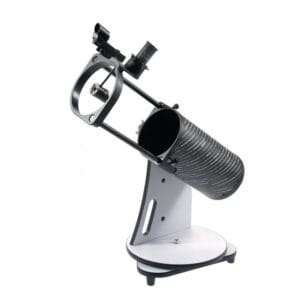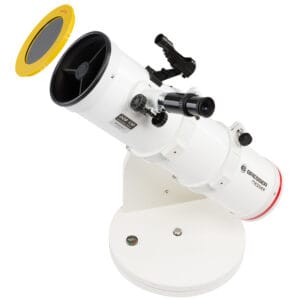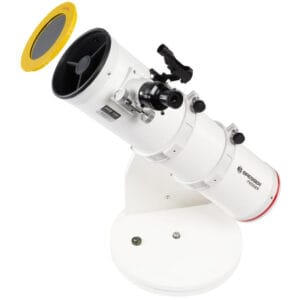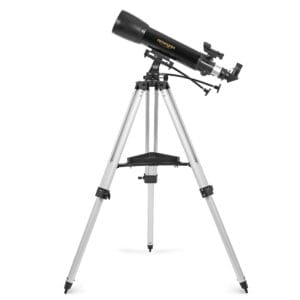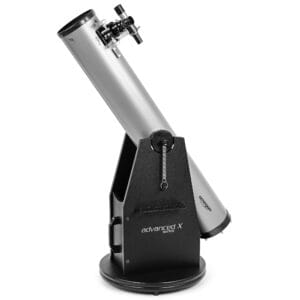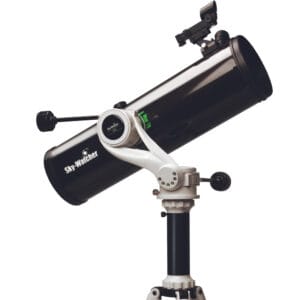For Beginners

Showing all 19 resultsSorted by popularity
Showing all 19 resultsSorted by popularity
Buying telescope for beginners - our recommendations & the basics explained
Viewing the moon or planets for the first time is something special. But as a beginner, you usually don't know where to start. What is a good telescope? How does it work? And what do you actually see with it? You want a telescope that works, not frustrates you. That's why we explain everything below as if you've never used a telescope before.
We distinguish two groups of beginners:
- Above all, you want to see with your own eyes → choose a visual telescope
- You especially want to take pictures or convenience → choose a smart telescope
Therefore, we begin with two clear top three lists.
Top 3 best telescopes for visual observation (beginners)
1. Omegon Dobson 152/1200
The number one choice for visual observing. The large mirror captures a lot of light, making the moon, Jupiter, Saturn, Orion Nebula and Andromeda really impressive. Easy swivel base, no tripod shaking. This is the best choice if you want strong images right away.
2. Celestron StarSense Explorer 114/1000
The best choice if you like a telescope on tripod with smartphone navigation. The app shows you exactly where to aim. Perfect if you are afraid that “finding objects” is difficult. Great for the moon, Jupiter, Saturn and bright deep-sky objects.
3. The largest Dobson within your budget (150/1200 or 203/1200).
For visual viewing, one golden rule applies: the bigger the mirror, the more you see. So if the 203/1200 is out of budget, choose the largest Dobson that will fit. A 150/1200 or 200/1200 will give much more results than smaller entry-level models.
Top 3 best smart telescopes (photo taking & convenience)
1. Seestar S50
The most popular smart telescope right now. You put it down, open the app and it automatically looks up objects. Within seconds you see color images of the Orion Nebula, Andromeda, star clusters and the moon. Ideal for families and beginners.
2. Dwarf 3
More adjustability than the Seestar. Larger field of view, perfect for larger deep-sky objects such as Andromeda. Also suitable for birds and the moon. For beginners who want to shoot directly but want a little more tweaking.
3. Seestar S30
Affordable version of the S50. Larger field of view, set up quickly, very easy to use. Ideal if you mainly want to explore without a big investment.
Just what is the difference between these telescopes?
1. Do you want to see with your own eyes?
Then you choose a visual telescope such as a Dobson or a refractor on a tripod.
- You see real photons from space with your own eyes; you look through an eyepiece;
- The experience feels “more real,” authentic;
- Perfect for the moon, planets and bright nebulae;
- More wow experience than pictures on a screen (one is not better than the other, it is purely what you want to experience yourself. Seeing the rings of Saturn through an eyepiece is truly a magical experience).
A Dobson gives by far the most value for your money: this is a large mirror on a wooden swivel base. No vibrating tripod, no complicated controls. You just turn it by hand.
A tripod-telescope like the StarSense 114/1000 is more convenient on balcony, lighter and has app navigation. Ideal for beginners who don't want to search.
2. Do you mainly want to take pictures or no fuss?
Then you choose a smart telescope.
A smart telescope is a kind of mini-astrophotography system:
- You open the app.
- The system searches for stars and objects on its own.
- You will see the object on your screen within seconds.
- The picture gets better and better as it takes more pictures.
Under city light/ in the city, smart telescopes perform even better than a regular telescope because they digitally amplify.
What do you see as a beginner? Realistic expectations
With a visual telescope:
- The moon: sharp craters, mountain ranges, impressive contrast
- Jupiter: cloud bands + four moons
- Saturn: the ring is clearly visible
- Mars: small red disk, sometimes a polar cap
- Orion nebula: hazy gas cloud with structure
- Andromeda: large oval spot with light core
- Pleiades: brilliant blue star cluster
With a smart telescope:
- The Orion Nebula in color (purple, green, blue)
- Andromeda as a large galaxy
- Pleiades in sharp shades of blue
- Craters on the moon extremely detailed
- Clusters and nebulae that are visually more difficult
Dobson or tripod? Here's how to choose
Choose a Dobson if:
- You want the best image quality for your money
- You are mostly in the garden
- You want to see deep-sky objects
- You don't mind the telescope being big & heavy
Dobsons are the favorite of almost all beginners who “want to see the most.”.
Choose a tripod telescope like:
- You are on a balcony or small space
- You prefer a lighter setup
- Wanting your smartphone navigation (StarSense)
- You mainly want to view planets and the moon
- You will take the telescope with you often
Smart telescope or ordinary telescope?
It depends on what you are looking for in your first experience:
- Want the real ‘wow, I'm seeing it with my own eyes’ experience? → take the Omegon Dobson 203/1200.
- Do you especially want to take pictures and convenience? → take the Seestar S50.
- Want a mix of visual and photography? → Then choose a telescope on a Equatorial mount. That is jargon for a telescope that compensates for the earth's rotation. This is essential for photography! But this can also be upgraded later - you can also go for a Skywatcher, for example Skymax telescope within your budget.
Realistic mistakes beginners often make
- Paying too much attention to “magnification” when clarity and stability are more important.
- Thinking deep-sky objects are visually in color (that's only with smart telescopes).
- Buying a telescope that is too small because it is cheap.
- Not understanding that the second value (such as 1200 in 203/1200) determines how large planets become.
With planets, always choose a telescope with a long focal length. The Omegon 152/1200 and the StarSense 114/1000 are perfect for this.
Which beginner's scope is right for you?
The choice depends mostly on what you want to see and how you want to look.
If you seek the real experience of looking at the moon, Jupiter or Saturn with your own eyes, then a Dobson will suit you best. The Omegon Dobson 152/1200 is at the top of the list then: large mirror area, stable, easy to move and impressively clear image. If that model is over budget, choose the largest Dobson that does fit within your capabilities. The larger the mirror, the more you see.
For those who primarily want to view planets and like the fact that the telescope helps with aiming, a model like the Celestron StarSense Explorer 114/1000 is ideal. The long focal length makes planets larger and more visible, and the app navigation ensures you never have to search.
If your primary focus is picture-taking or convenience, then a smart telescope will suit you better. The Seestar S50 is the most complete choice: you set it down, open the app and the telescope looks up objects by itself. This way, you instantly take color images of nebulae and star clusters. The Dwarf 3 is a strong alternative if you like a wider field of view and a little more control over settings. The Seestar S30 is a good option if you want to start out especially low-key.
In short: those who want the best results visually will choose a Dobson; those looking primarily for planets will choose the StarSense 114/1000 or a Maksutov telescope within your budget; those who want pictures and convenience choose a smart telescope such as the Seestar S50 or Dwarf 3.
Why a Maksutov telescope is perfect for planets
Many beginners don't hear about the Maksutov telescope until later, even though this type is actually one of the best choices for anyone who wants to view mostly planets and the moon. A Maksutov (often abbreviated as “Mak”) is a compact reflecting telescope with a relatively small aperture, but a very long focal length. The latter is exactly why it is so suitable for planets.
Whereas traditional beginner binoculars often have a focal length of 650 or 750 millimeters, a Maksutov quickly sits at 1300 millimeters or even more. That long focal length magnifies planets in a natural, stable way. Jupiter becomes not a tiny dot but a clear disk with cloud bands; Saturn shows its ring detached from the planet; the moon shows sharp shadow lines and fine detail along the terminator. The image feels calmer, less “dancing,” and many beginners find it easier to really see what they are looking for as a result.
Maksutovs have another advantage: they are completely sealed. No dust gets into the telescope, you don't need to collimate, and they stay exactly as you buy them for years. That makes them ideal for those who want a low-maintenance telescope that is always ready to go - even on a balcony or in the city.
Because the image is so sharp and full of contrast, you can later expand a Maksutov into simple photography. Think moon shots with a smartphone adapter, or planetary shots with a small camera like a ZWO planetary camera. Because of its long focal length, a Mak actually works to your advantage in this type of shooting: you have a lot of magnification without the need for extreme eyepieces.
The only drawback is that a Maksutov is less suitable for large deep-sky objects such as the Orion Nebula or Andromeda. This is due to the narrower field of view. But those who mainly want to see planets will get one of the best images within a compact size with a Maksutov.

